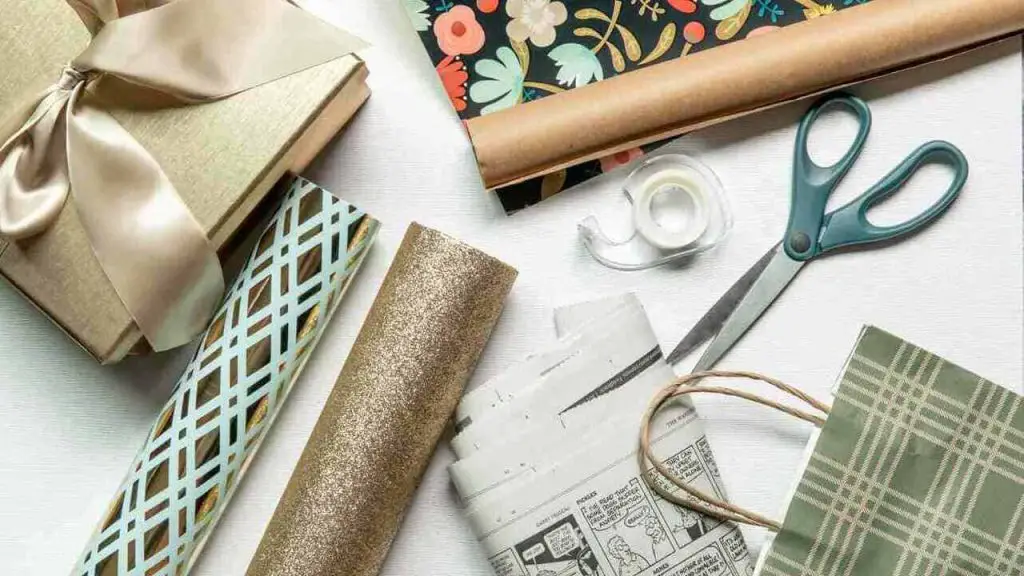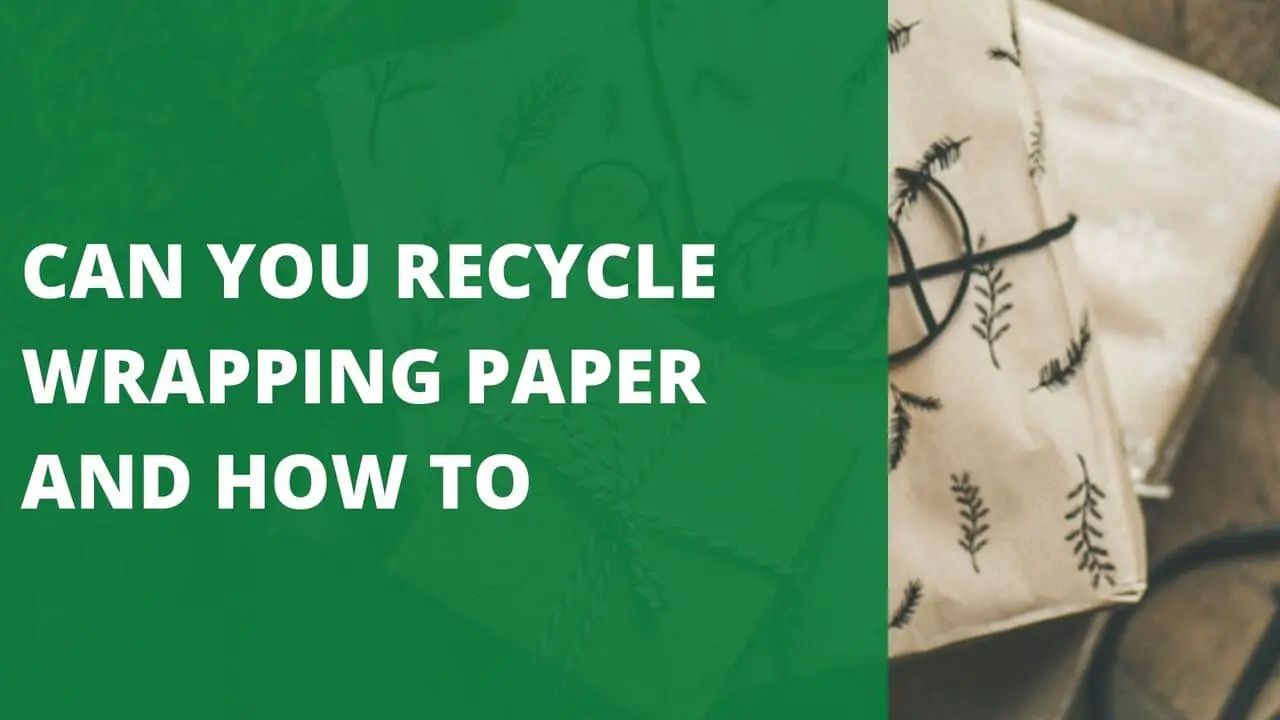As an Amazon Associate I earn from qualifying purchases.
The holidays are a time when a lot of wrapping paper is used. Most people throw it away after the presents are opened, but that’s not the best way to handle it!
Wrapping paper without additional materials, such as metals, plastics, or glitter, can often be recycled. If the wrapping paper has these extras on it, unfortunately, it cannot be recycled and should go in the trash instead.
An example of this would be the wrapping paper in this link which looks nice but has glitter all over it.
This blog post will discuss how you can recycle your wrapping paper. There are many ways to do this, and we will cover them all in detail.
By recycling your wrapping paper, you can help reduce the amount of waste that is produced each year!

Can you Recycle Wrapping Paper and How to: Paper Recycling Process
The process of recycling paper, whether you do it individually or on a large scale, is mostly the same.
There can be some variations, depending on how thick or lightweight the paper you recycle is. For example, thin newspapers will require fewer steps than thicker cardboard boxes.
Furthermore, other steps can be taken to remove more contaminants in the paper, such as bisphenol A, phthalates, phenols, mineral oils, and polychlorinated biphenyls (PCBs).
Step 1: Collection
The first step to recycling paper is done by individual users who put waste paper in bins.
Recyclers and those who sell paper gather it and put it all together in one big container meant for recycling.
Step 2: Sorting and Transportation
After the paper is collected, it is measured and graded for quality. Similar waste papers are combined because they contain similar amounts of fiber that can be extracted from the pulp. The paper is then transported to recycling facilities.
After the recycling facility receives the paper, they inspect its purity and type to decide whether they will buy it from the recycler.
The facility uses these same metrics to determine if certain types of waste paper are up to their standards; some places accept lower quality grades while others only want higher grades.
The recycled paper goes through another round of sorting at the recycling facility, this time according to surface treatment and structure.
For example, newspapers are sorted separately from thick materials like paper folders. This is important because different recycled paper grades are made depending on the materials used.
Step 3: Shredding and Pulping
Once the paper is sorted, it is put into a shredder to be torn into small pieces.
Once it has been finely shredded, vast amounts of water and other chemicals such as hydrogen peroxide, sodium hydroxide, and sodium silicate are added to break down and separate the fibers of the paper.
The final slurry solution, called the pulp, has a texture similar to oatmeal and is the base necessary to make paper. This journey from recovered materials into pulp is referred to as pulping.
The pulp is then passed through a series of screens and a centrifuge-like process to remove contaminants such as paper clips, staples, tape, and plastic films.
Step 4: Floatation Tank
After the initial stages of removing contaminants, the pulp is added to a flotation tank. Here, chemicals and air bubbles remove any remaining dyes or inks.
This leaves behind a purer, whiter product. If a white color is desired for the product, hydrogen peroxide and other whitening agents may be added to enhance the whiteness of the pulp. This repeated bleaching process continues until it is ready for final processing.
To produce colored products, sometimes dyers add dyes. To create a brilliantly white printing paper, in some instances, they mix in small doses of black and blue dye.
On the other hand, paper pulp used for brown paper towels doesn’t go through a bleaching process.
After the water is extracted from the pulp, it is mixed with new fibers to improve its strength. From there, it gets pumped into a machine that creates paper.
Step 5: Finishing for Reuse
The water is then pressed out of the pulp using rollers, or a machine that vibrates, to create a final product that consists of 50 percent water and 50 percent fiber.
The pulp can be used on its own, or virgin wood fiber can be added to it for extra strength or smoothness.
Coated paper, which is smoother and ideal for printing, can be achieved by adding a coating mixture to the paper near the end of its creation or afterward.
The sheets of paper are passed through steam-heated rollers at temperatures as high as 130 degrees Fahrenheit. This process results in long rolls of flattened paper up to 30 feet wide and 27 metric tons in weight.
Various starches like potato starch are sometimes sprayed onto paper during its creation to prevent ink from seeping and smudging like it would on tissue paper.
The unusable, trimmed-off ends of the roll are recycled back into the system to create new pulp.
Once the long roll has been cut down into more manageable sizes, it is sent off to different manufacturers who use paper for their products; this includes but is not limited to: newspaper printing, wrapping paper, typical printer paper, and blown-in cellulose insulation.
Although paper can be recycled multiple times, there is still a limit to how much-recovered paper can be reused.
After the initial recycling process, individual paper fibers shorten more and more each time they are recycled until, eventually, products like cardboard egg cartons can no longer go through the process again.
The Bottom Line
Wrapping paper is recyclable. The key is to ensure it is sorted correctly and all the contaminants are removed. Once that’s done, shredded paper can be turned into pulp and reimagined into new products for consumers.
With an increasing number of people becoming more eco-friendly, recycling wrapping paper is a great way to reduce waste and help the environment.
Recycling wrapping paper is also a great way to reduce costs and promote sustainability. If you’re looking for an easy way to make a positive impact, consider recycling wrapping paper next time you unwrap a present.
FAQs
Can I recycle plastic from wrapping paper?
Most wrapping paper cannot be recycled because it is dyed, laminated, or contains non-paper materials like glitter and plastics.
The sticky tape makes recycling difficult even if the paper itself is recyclable.
What type of paper is not recyclable?
Coated and treated paper and paper contaminated with food waste, juice or cereal boxes, paper cups, and laminated plastic cannot be recycled.
Additional Contents
- Can you Recycle Glass and How to: Things to Know
- Can You Recycle Bubble Wrap and How to
- Where to Recycle Cardboard and How to: 5 Best Ways
- 10 Best Recycle Bins For Home To Collect Waste
- How to Recycle Packing Peanuts: 10 Effective Ways to Save the Environment
Amazon and the Amazon logo are trademarks of Amazon.com, Inc, or its affiliates.


